Variation and Episodes of Near-Inertial Internal Waves on the Continental Slope of the Southeastern East China Sea
Abstract
1. Introduction
2. Data and Methods
2.1. In Situ Observations and Typhoon
2.2. Satellite and Reanalysis Data
2.3. Methods
3. Results
3.1. Seasonal Variation
3.2. Episodes of NIWs
3.2.1. NIKE and Excitation Mechanism
3.2.2. Near-Inertial Currents and Shear
3.2.3. Frequency and Phase of NIWs
3.2.4. E-Folding Time of NIWs
4. Discussion
5. Conclusions
Author Contributions
Funding
Institutional Review Board Statement
Informed Consent Statement
Data Availability Statement
Acknowledgments
Conflicts of Interest
References
- Watanabe, M.; Hibiya, T. Global estimates of the wind-induced energy flux to inertial motions in the surface mixed layer. Geophys. Res. Lett. 2002, 29, 1239. [Google Scholar] [CrossRef]
- Furuichi, N.; Hibiya, T.; Niwa, Y. Model-predicted distribution of wind-induced internal wave energy in the world’s oceans. J. Geophys. Res. Oceans 2008, 113, C09034. [Google Scholar] [CrossRef]
- Simmons, H.L.; Alford, M.H. Simulating the long-range swell of internal waves generated by ocean storms. Oceanography 2012, 25, 30–41. [Google Scholar] [CrossRef]
- Rimac, A.; von Storch, J.S.; Eden, C.; Haak, H. The influence of high-resolution wind stress field on the power input to near-inertial motions in the ocean. Geophys. Res. Lett. 2013, 40, 4882–4886. [Google Scholar] [CrossRef]
- Egbert, G.D.; Ray, R.D. Significant dissipation of tidal energy in the deep ocean inferred from satellite altimeter data. Nature 2000, 405, 775–778. [Google Scholar] [CrossRef] [PubMed]
- Wunsch, C. The work done by the wind on the oceanic general circulation. J. Phys. Oceanogr. 1998, 28, 2332–2340. [Google Scholar] [CrossRef]
- Alford, M.H.; MacKinnon, J.A.; Simmons, H.L.; Nash, J.D. Near-inertial internal gravity waves in the ocean. Annu. Rev. Mar. Sci. 2016, 8, 95–123. [Google Scholar] [CrossRef]
- Chen, Z.; Chen, S.; Liu, Z.; Xu, J.; Xie, J.; He, Y.; Cai, S. Can tidal forcing alone generate a GM-like internal wave spectrum. Geophys. Res. Lett. 2019, 46, 14644–14652. [Google Scholar] [CrossRef]
- Hu, Q.; Huang, X.; Zhang, Z.; Zhang, X.; Xu, X.; Sun, H.; Zhou, C.; Zhao, W.; Tian, J.W. Cascade of internal wave energy catalyzed by eddy-topography interaction in the deep South China Sea. Geophys. Res. Lett. 2019, 47, e2019GL086510. [Google Scholar] [CrossRef]
- Soares, S.M.; Natarov, A.; Richards, K.J. Internal swells in the tropics: Near-inertial waves energy fluxes and dissipation during CINDY. J. Geophys. Res. Oceans 2016, 121, 3297–3324. [Google Scholar] [CrossRef]
- Chen, G.X.; Xue, H.J.; Wang, D.X.; Xie, Q. Observed near-inertial kinetic energy in the northwestern South China Sea. J. Geophys. Res. Oceans 2013, 118, 4965–4977. [Google Scholar] [CrossRef]
- Yang, B.; Hou, Y.J.; Hu, P.; Liu, Z.; Liu, Y.H. Shallow Ocean response to tropical cyclones observed on the continental shelf of the northwestern South China Sea. J. Geophys. Res. Oceans 2015, 120, 3817–3836. [Google Scholar] [CrossRef]
- Subeesh, M.P.; Unnikrishnan, A.S. Observed internal tides and near-inertial waves on the continental shelf and slope off Jaigarh, central west coast of India. J. Mar. Syst. 2016, 157, 1–19. [Google Scholar] [CrossRef]
- Cao, A.; Guo, Z.; Song, J.; Lv, X.; He, H.; Fan, W. Near-inertial waves and their underlying mechanisms based on the South China Sea internal wave experiment (2010–2011). J. Geophys. Res. Oceans 2018, 123, 5026–5040. [Google Scholar] [CrossRef]
- Jeon, C.; Park, J.H.; Park, Y.G. Temporal and spatial variability of near-inertial waves in the East/Japan Sea from a high-resolution wind-forced ocean model. J. Geophys. Res. Oceans 2019, 124, 6015–6029. [Google Scholar] [CrossRef]
- Kawaguchi, Y.; Wagawa, T.; Igeta, Y. Near-inertial internal waves and multiple-inertial oscillations trapped by negative vorticity anomaly in the central Sea of Japan. Prog. Oceanogr. 2020, 181, 102240. [Google Scholar] [CrossRef]
- Park, J.J.; Kim, K.; Schmitt, R.W. Global distribution of the decay timescale of mixed layer inertial motions observed by satellite-tracked drifters. J. Geophys. Res. Oceans 2009, 114, C11010. [Google Scholar] [CrossRef]
- Alford, M.H.; Whitmont, M. Seasonal and spatial variability of near-inertial kinetic energy from historical moored velocity records. J. Phys. Oceanogr. 2007, 37, 2022–2037. [Google Scholar] [CrossRef]
- Silverthorne, K.E.; Toole, J.M. Seasonal kinetic energy variability of near-inertial motions. J. Phys. Oceanogr. 2009, 39, 1035–1049. [Google Scholar] [CrossRef]
- Yang, J.; Zhou, S.H.; Zhou, J.X.; Lynch, J.F. Internal wave characteristics at the ASIAEX site in the East China Sea. IEEE J. Ocean. Eng. 2004, 29, 1054–1060. [Google Scholar] [CrossRef]
- Li, X.F.; Zhao, Z.X.; Han, Z.; Xu, L.X. Internal solitary waves in the East China Sea. Acta Oceanol. Sin. 2008, 27, 51–59. [Google Scholar]
- Cho, C.; Nam, S.H.; Song, H. Seasonal variation of speed and width from kinematic parameters of mode-1 nonlinear internal waves in the northeastern East China Sea. J. Geophys. Res. Oceans 2016, 121, 5942–5958. [Google Scholar] [CrossRef]
- Nam, S.; Kim, D.J.; Lee, S.W.; Kim, B.G.; Kang, K.M.; Cho, Y.K. Nonlinear internal wave spirals in the northern East China Sea. Sci. Rep. 2018, 8, 3473. [Google Scholar] [CrossRef]
- Park, J.H.; Lie, H.J.; Guo, B.H. Observation of semi-diurnal internal tides and near-inertial waves at the shelf break of the East China Sea. Ocean. Polar Res. 2011, 33, 409–419. [Google Scholar] [CrossRef][Green Version]
- Noh, S.S.; Seung, Y.H.; Lim, E.; You, H. Characteristics of semi-diurnal and diurnal currents at a KOGA station over the East China Sea shelf. Ocean. Polar Res. 2014, 36, 49–57. [Google Scholar] [CrossRef][Green Version]
- Lozovatsky, I.; Jinadasa, P.; Lee, J.H.; Fernando, H.J. Internal waves in a summer pycnocline of the East China Sea. Ocean. Dyn. 2015, 65, 1051–1061. [Google Scholar] [CrossRef]
- Yang, W.; Wei, H.; Zhao, L. Parametric subharmonic instability of the semidiurnal internal tides at the East China Sea shelf slope. J. Phys. Oceanogr. 2020, 50, 907–920. [Google Scholar] [CrossRef]
- Leaman, K.D.; Sanford, T.B. Vertical energy propagation of inertial waves: A vector spectral analysis of velocity profiles. J. Geophys. Res. 1975, 80, 1975–1978. [Google Scholar] [CrossRef]
- Alford, M.H.; Cronin, M.F.; Klymak, J.M. Annual cycle and depth penetration of wind-generated near-inertial internal waves at ocean station papa in the Northeast Pacific. J. Phys. Oceanogr. 2012, 42, 889–909. [Google Scholar] [CrossRef]
- Alford, M.H.; Gregg, M.C. Near-inertial mixing: Modulation of shear, strain and microstructure at low latitude. J. Geophys. Res. Oceans 2001, 106, 16947–16968. [Google Scholar] [CrossRef]
- Pollard, R.T.; Millard, R.C. Comparison between observed and simulated wind-generated inertial oscillations. Deep. Sea Res. Oceanogr. Abstr. 1970, 17, 813–821. [Google Scholar] [CrossRef]
- Oey, L.Y.; Ezer, T.; Wang, D.; Fan, S.; Yin, X. Loop Current warming by Hurricane Wilma. Geophys. Res. Lett. 2006, 33, L08613. [Google Scholar] [CrossRef]
- Geisler, J.E. Linear theory of the response of a two layer ocean to a moving hurricane. Geophys. Fluid Dyn. 1970, 1, 249–272. [Google Scholar] [CrossRef]
- Shen, J.Q.; Qiu, Y.; Zhang, S.F.; Kuang, F.F. Observation of tropical cyclone-induced shallow water currents in Taiwan Strait. J. Geophys. Res. Oceans 2017, 122, 5005–5021. [Google Scholar] [CrossRef]
- Xie, X.H.; Shang, X.D.; van Haren, H.; Chen, G.Y.; Zhang, Y.Z. Observations of parametric subharmonic instability-induced near-inertial waves equatorward of the critical diurnal latitude. Geophys. Res. Lett. 2011, 38, L05603. [Google Scholar] [CrossRef]
- Onuki, Y.; Hibiya, T. Excitation mechanism of near-inertial waves in baroclinic tidal flow caused by parametric subharmonic instability. Ocean Dyn. 2015, 65, 107–113. [Google Scholar] [CrossRef]
- Alford, M.H.; Shcherbina, A.Y.; Gregg, M.C. Observations of near-inertial internal gravity waves radiating from a frontal jet. J. Phys. Oceanogr. 2013, 43, 1225–1239. [Google Scholar] [CrossRef]
- Nagai, T.; Tandon, A.; Kunze, E.; Mahadevan, A. Spontaneous generation of near-inertial waves by the Kuroshio front. J. Phys. Oceanogr. 2015, 45, 2381–2406. [Google Scholar] [CrossRef]
- Perkins, H. Observed effect of an eddy on inertial oscillations. Deep. Sea Res. Oceanogr. Abstr. 1976, 23, 1037–1042. [Google Scholar] [CrossRef]
- Kunze, E. Near-inertial wave propagation in geostrophic shear. J. Phys. Oceanogr. 1985, 15, 544–565. [Google Scholar] [CrossRef]
- Sun, L.; Zheng, Q.; Wang, D.; Hu, J.; Tai, C.K.; Sun, Z. A case study of near-inertial oscillation in the South China Sea using mooring observations and satellite altimeter data. J. Oceanogr. 2011, 67, 677–687. [Google Scholar] [CrossRef]
- Jeon, C.; Park, J.H.; Nakamura, H.; Nishina, A.; Zhu, X.H.; Kim, D.G.; Min, H.S.; Kang, S.K.; Na, H.; Hirose, N. Poleward-propagating near-inertial waves enabled by the western boundary current. Sci. Rep. 2019, 9, 9955. [Google Scholar] [CrossRef]
- Jing, Z.; Wu, L.; Ma, X. Energy exchange between the mesoscale oceanic eddies and wind-forced near-inertial oscillations. J. Phys. Oceanogr. 2017, 47, 721–733. [Google Scholar] [CrossRef]
- Jing, Z.; Chang, P.; Dimarco, S.F.; Wu, L. Observed energy exchange between low-frequency flows and internal waves in the Gulf of Mexico. J. Phys. Oceanogr. 2018, 48, 995–1008. [Google Scholar] [CrossRef]
- Noh, S.S.; Nam, S. Observations of enhanced internal waves in an area of strong mesoscale variability in the southwestern East Sea (Japan Sea). Sci. Rep. 2020, 10, 9068. [Google Scholar] [CrossRef]
- Nakamura, H.; Inoue, R.; Nishina, A.; Nakano, T. Seasonal variations in salinity of the North Pacific Intermediate Water and vertical mixing intensity over the Okinawa Trough. J. Oceanogr. 2021, 77, 199–213. [Google Scholar] [CrossRef]
- Nagai, T.; Hasegawa, D.; Tanaka, T.; Nakamura, H.; Tsutsumi, E.; Inoue, R.; Yamashiro, T. First evidence of coherent bands of strong turbulent layers associated with high-wavenumber internal shear in the upstream Kuroshio. Sci. Rep. 2017, 7, 14555. [Google Scholar] [CrossRef]
- Nagai, T.; Duran, G.S.; Otero, D.A.; Mori, Y.; Yoshie, N.; Ohgi, K.; Hasegawa, D.; Nishina, A.; Kobari, T. How the Kuroshio current delivers nutrients to sunlit layers on the continental shelves with aid of near-inertial waves and Turbulence. Geophys. Res. Lett. 2019, 46, 6276–6735. [Google Scholar] [CrossRef]
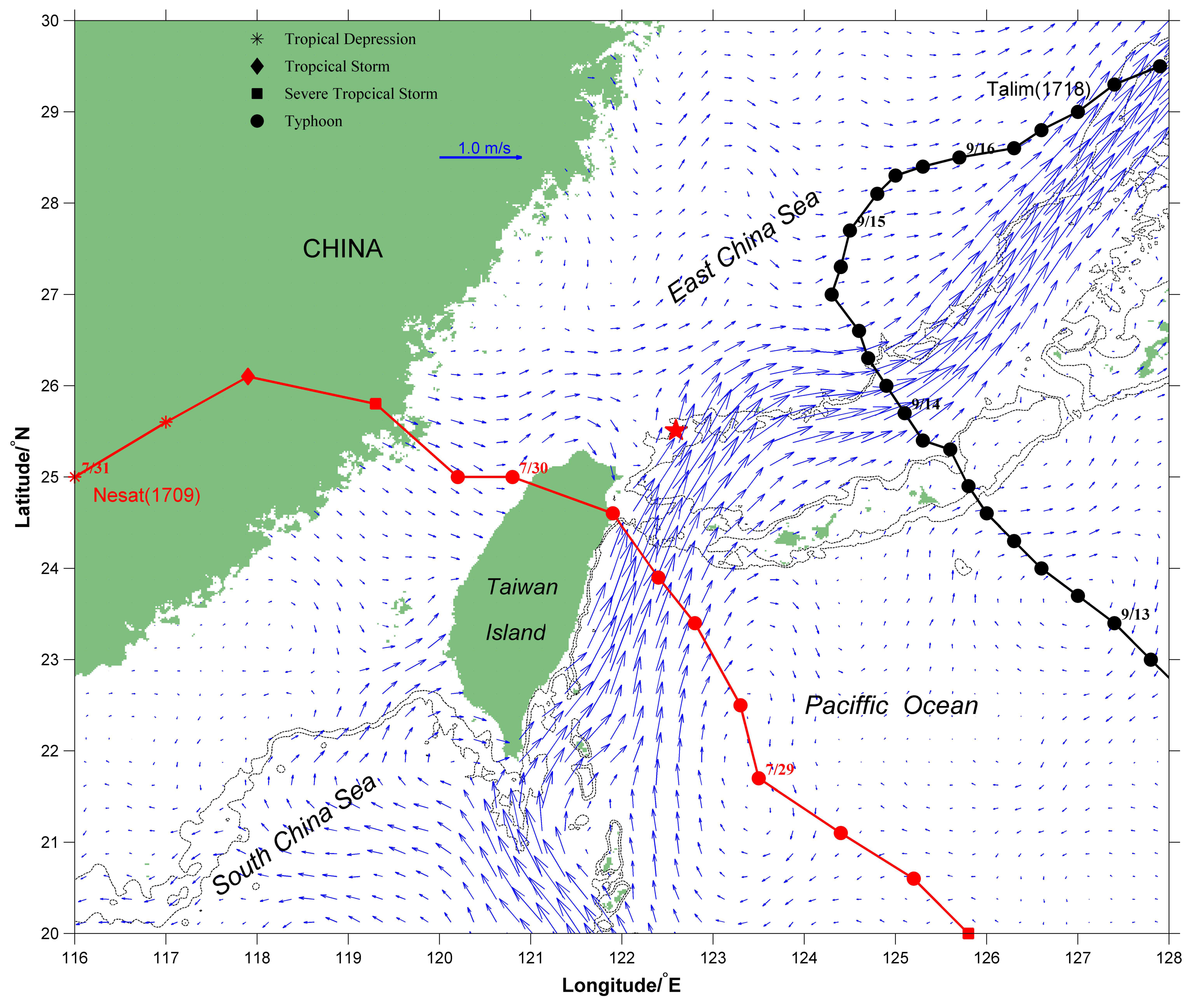
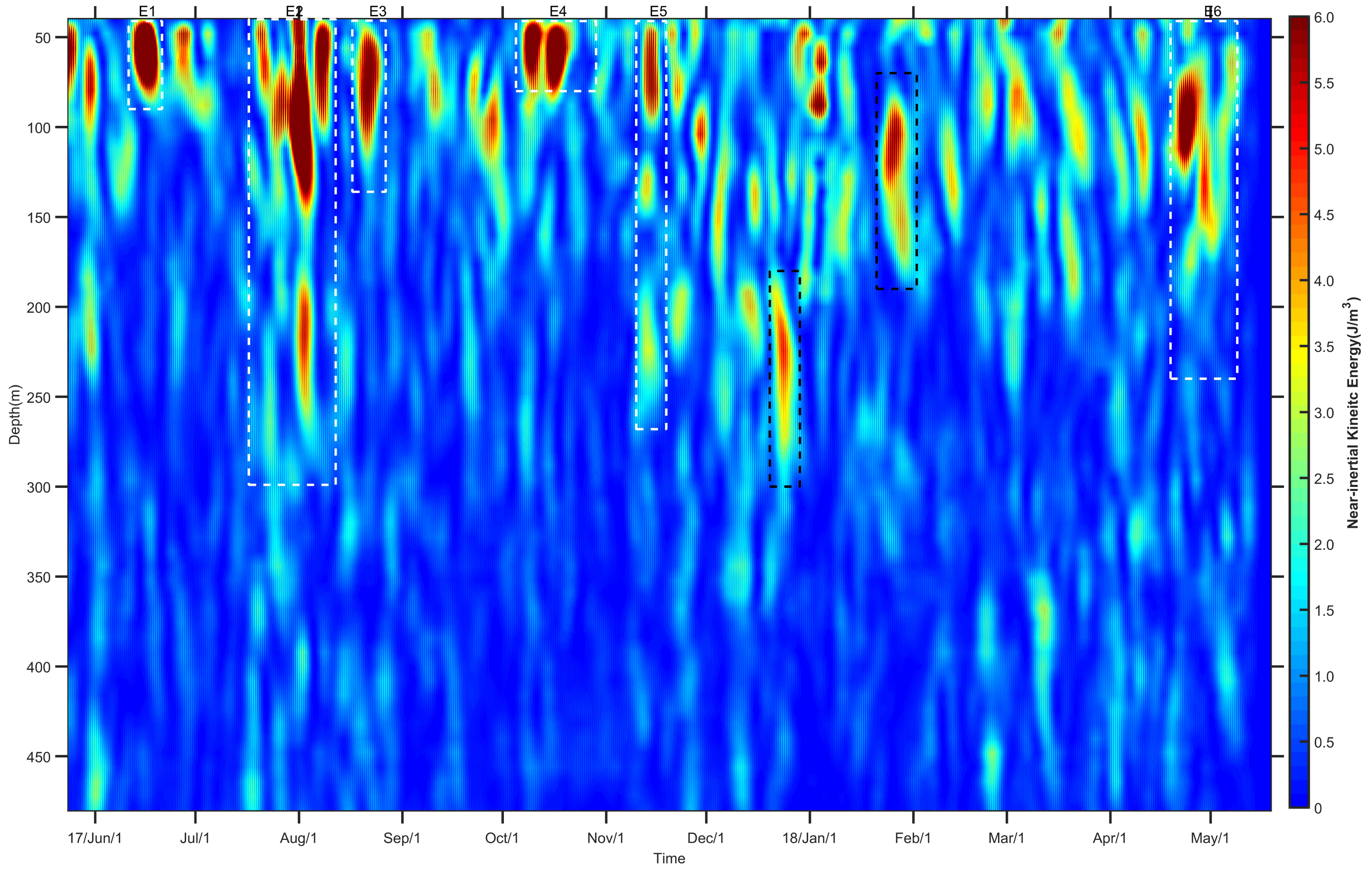
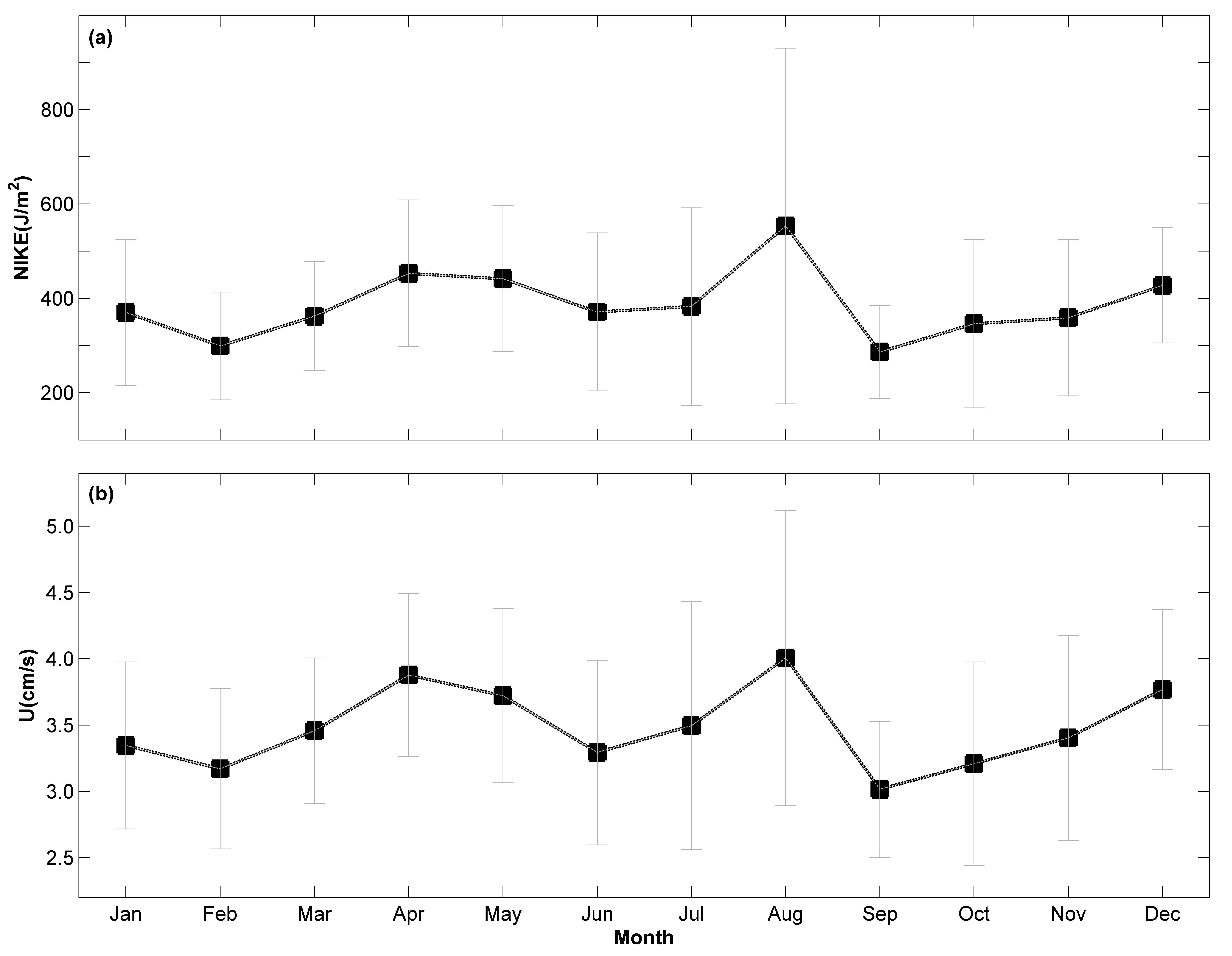
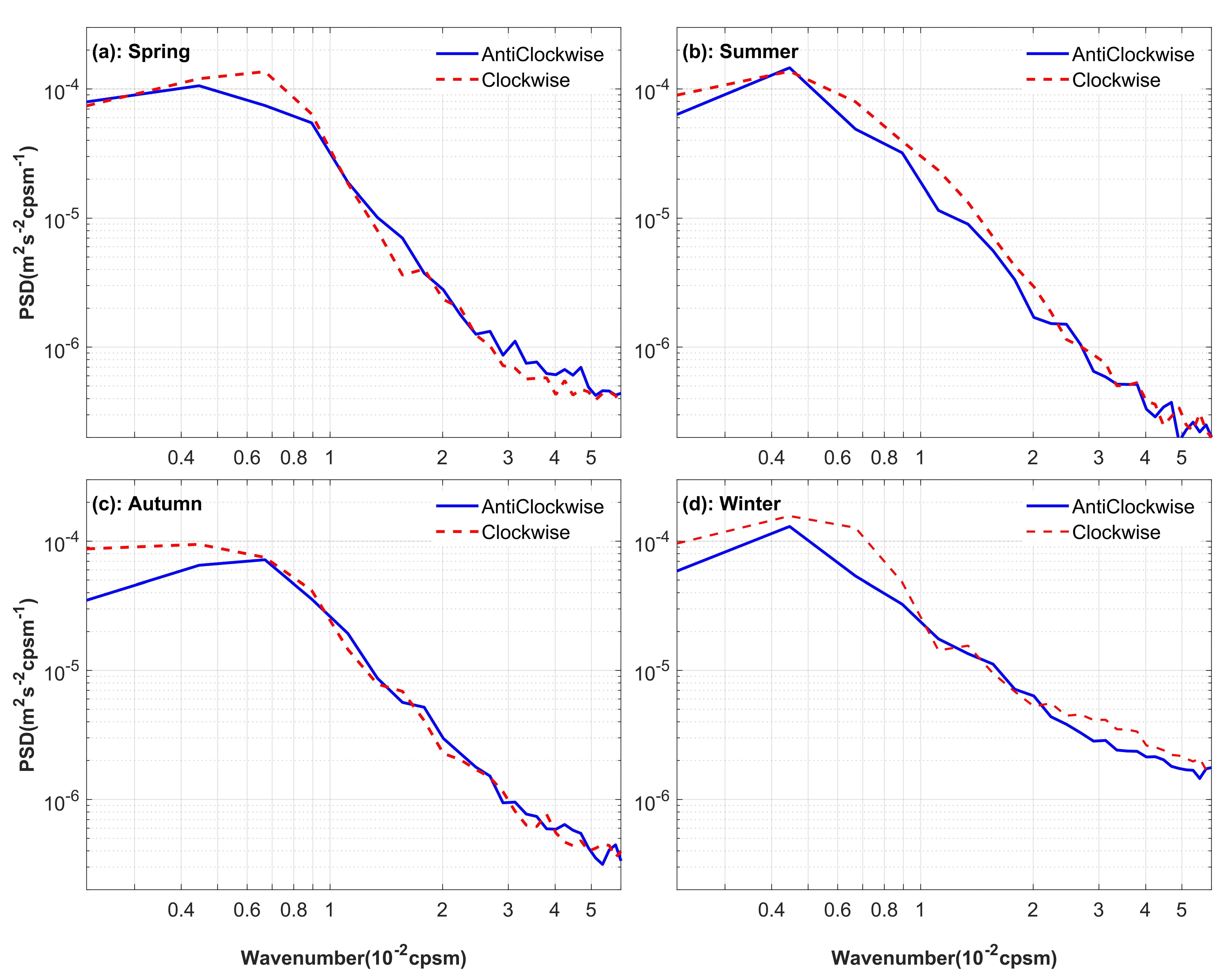
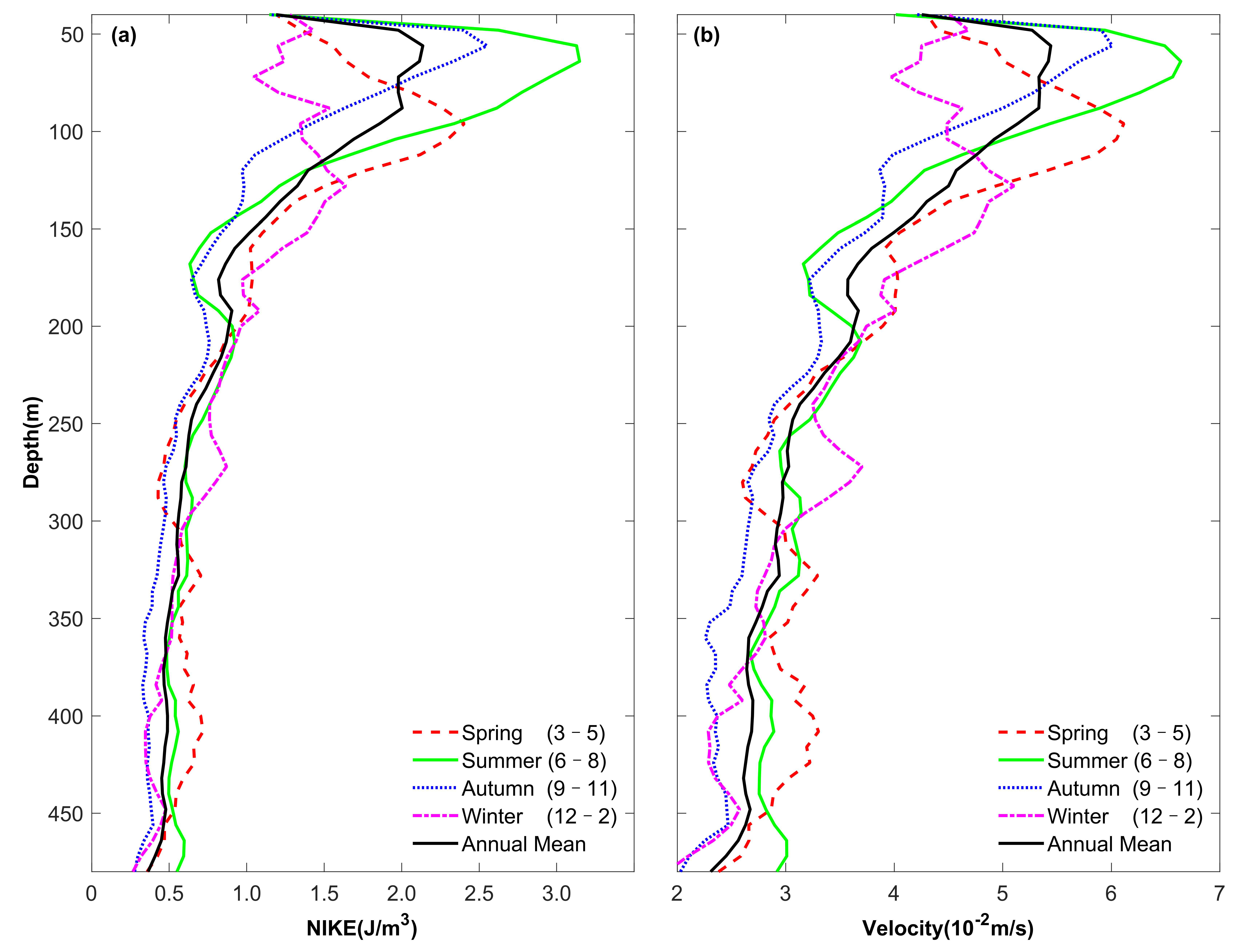
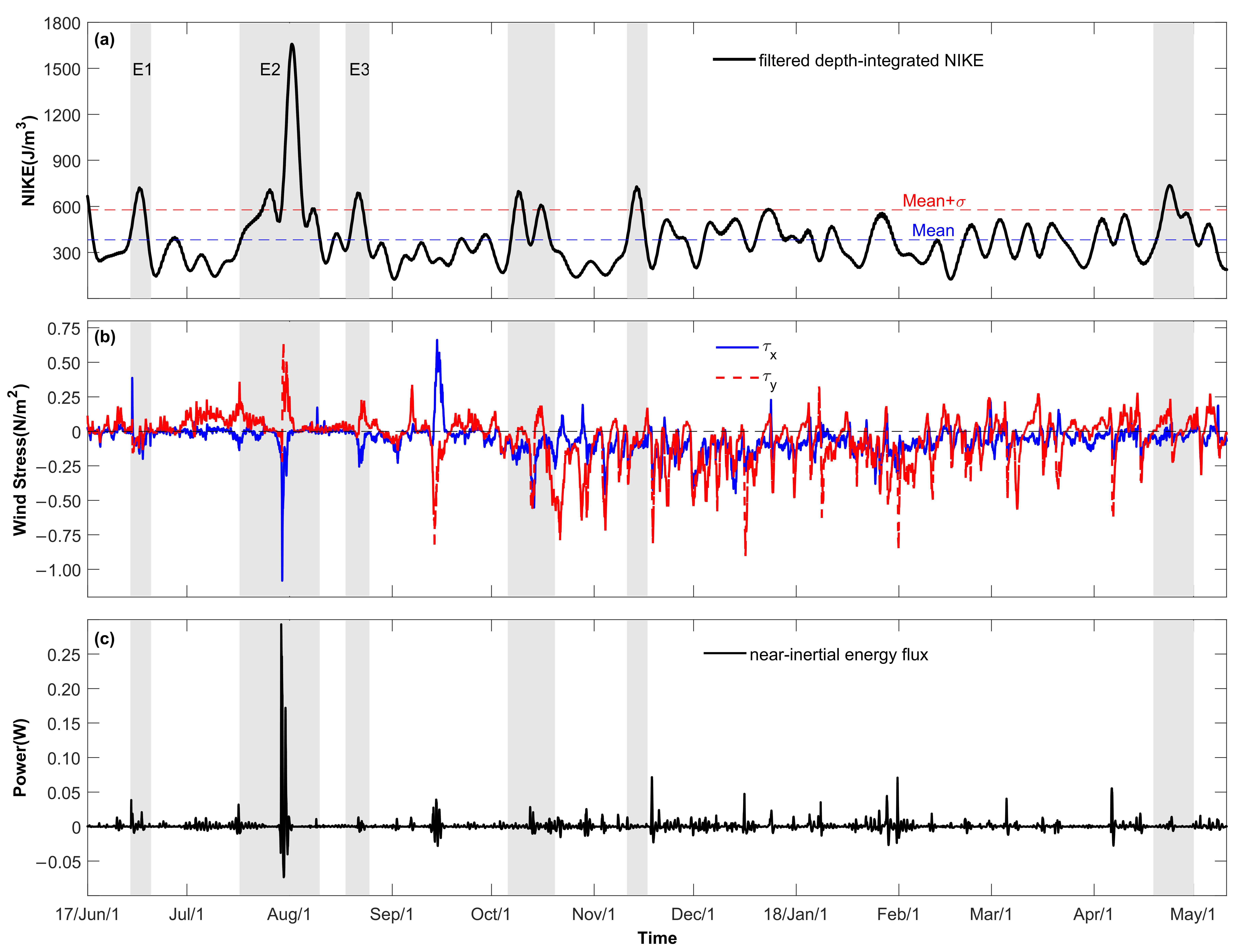
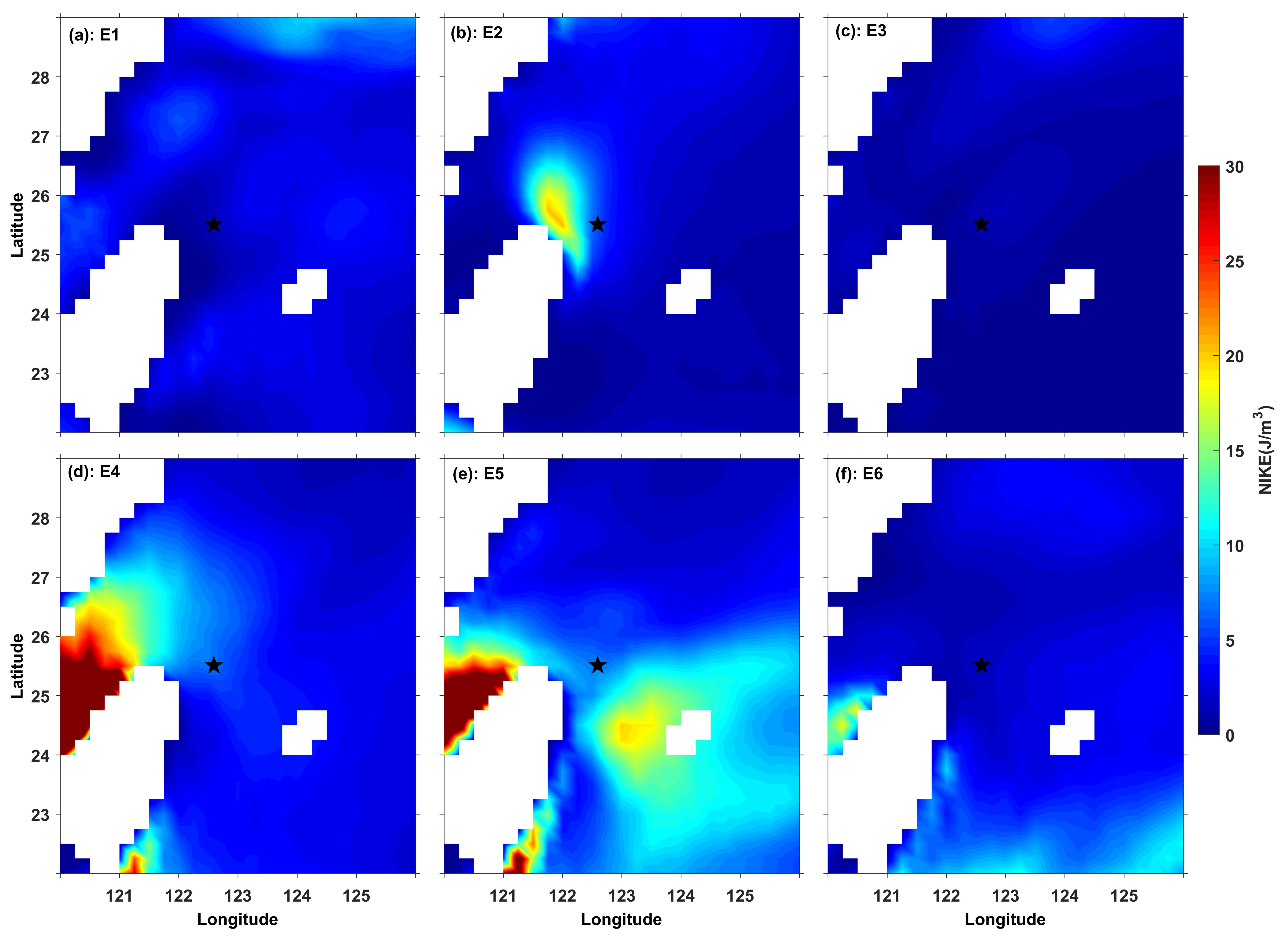
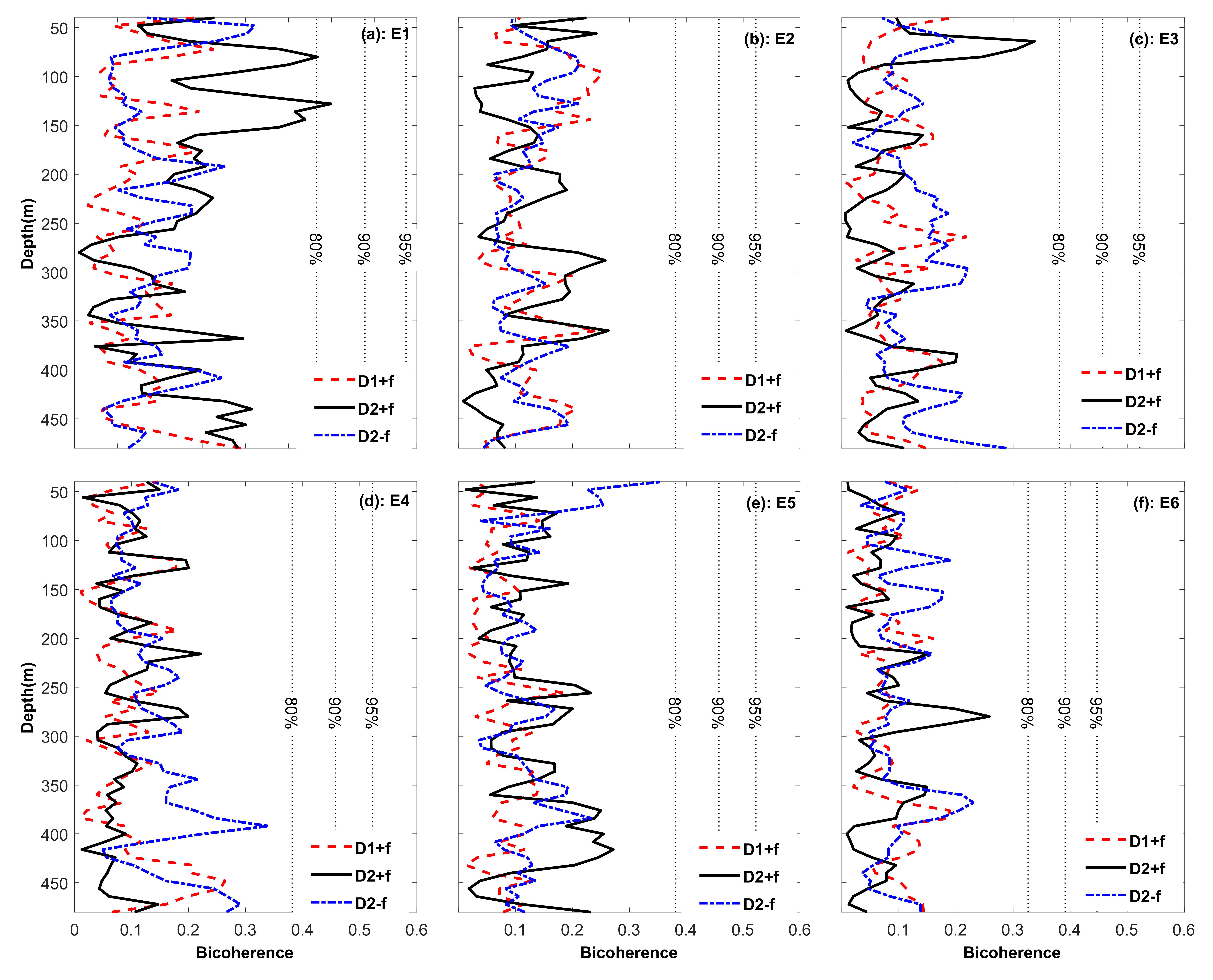

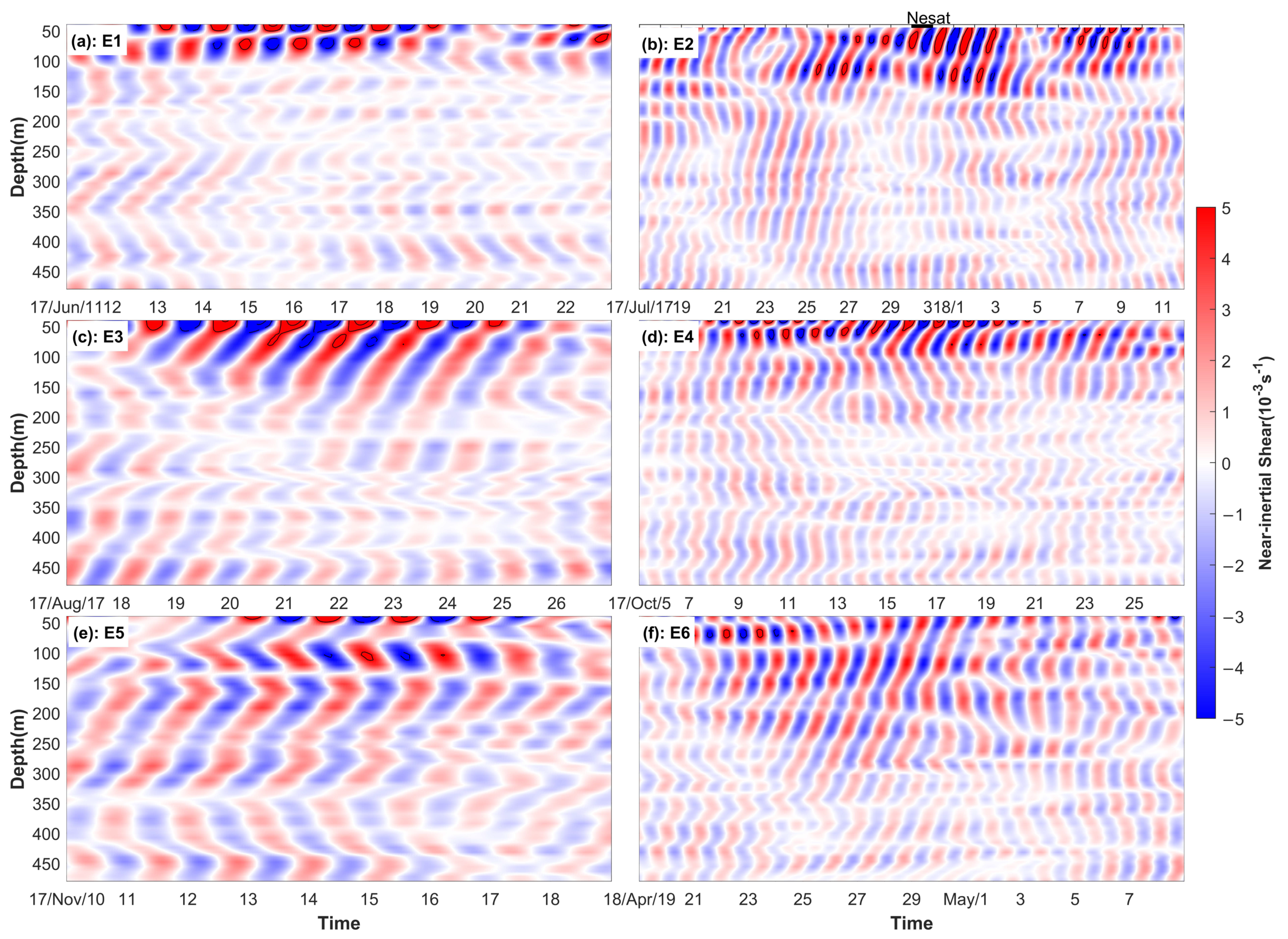
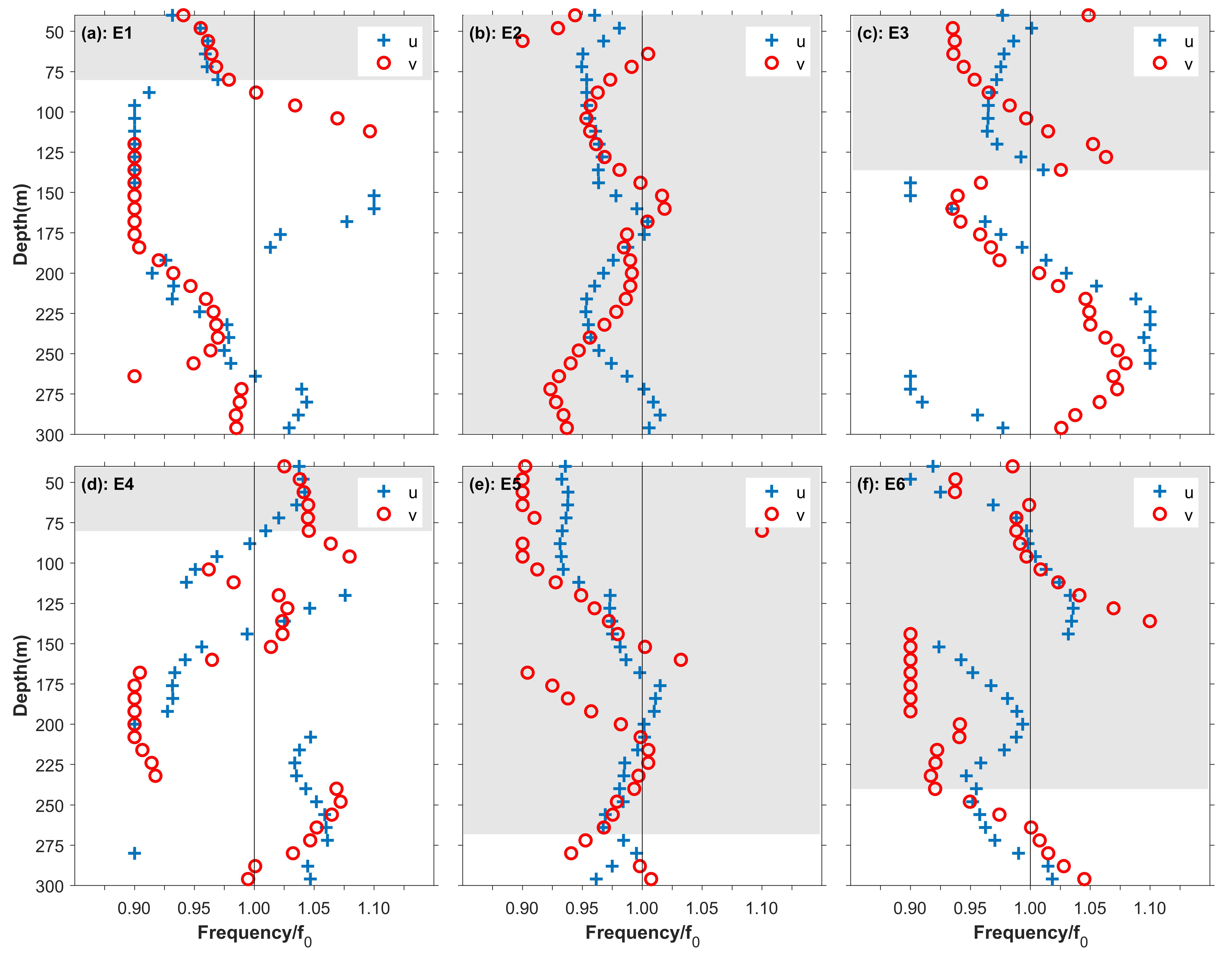
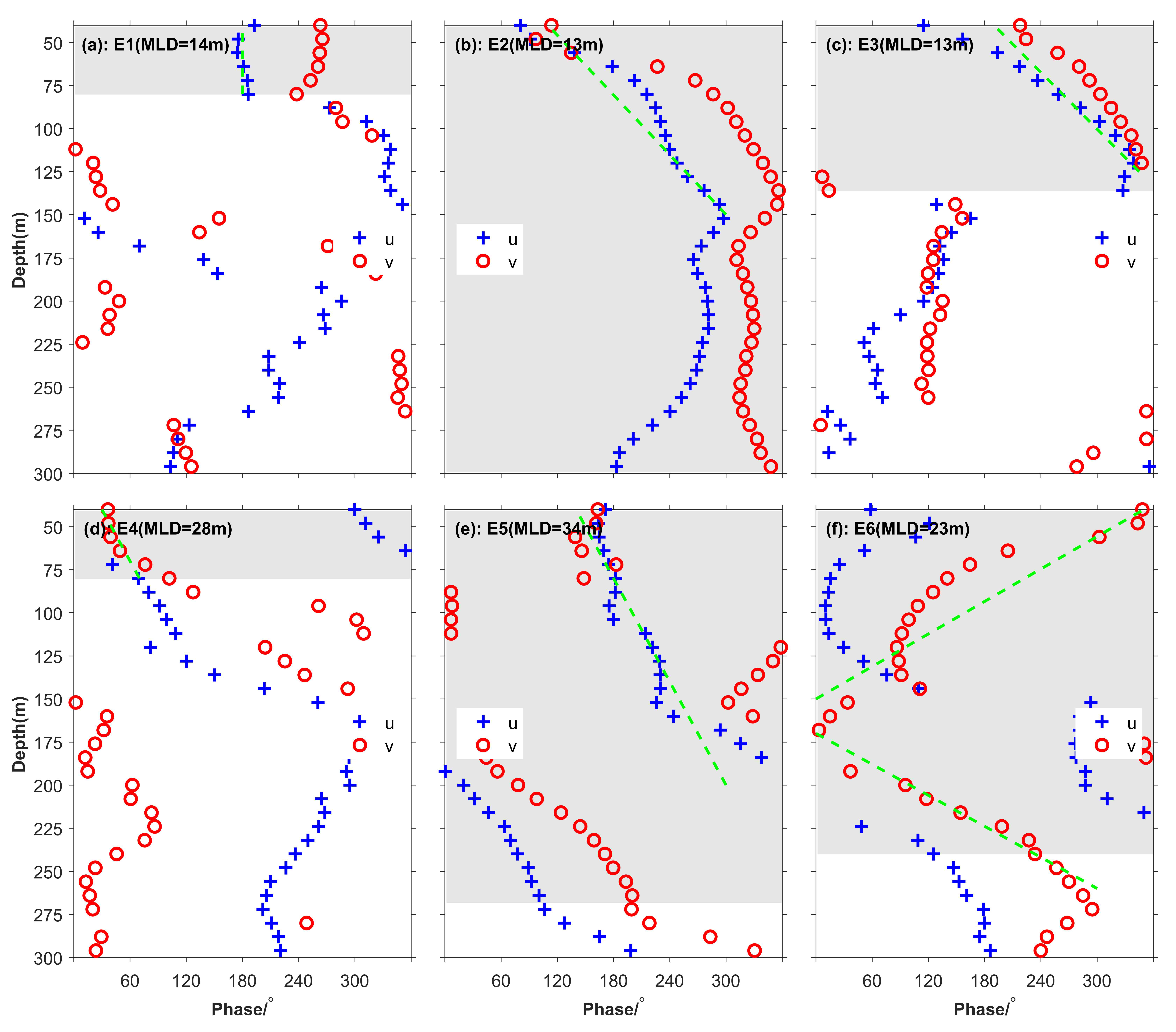
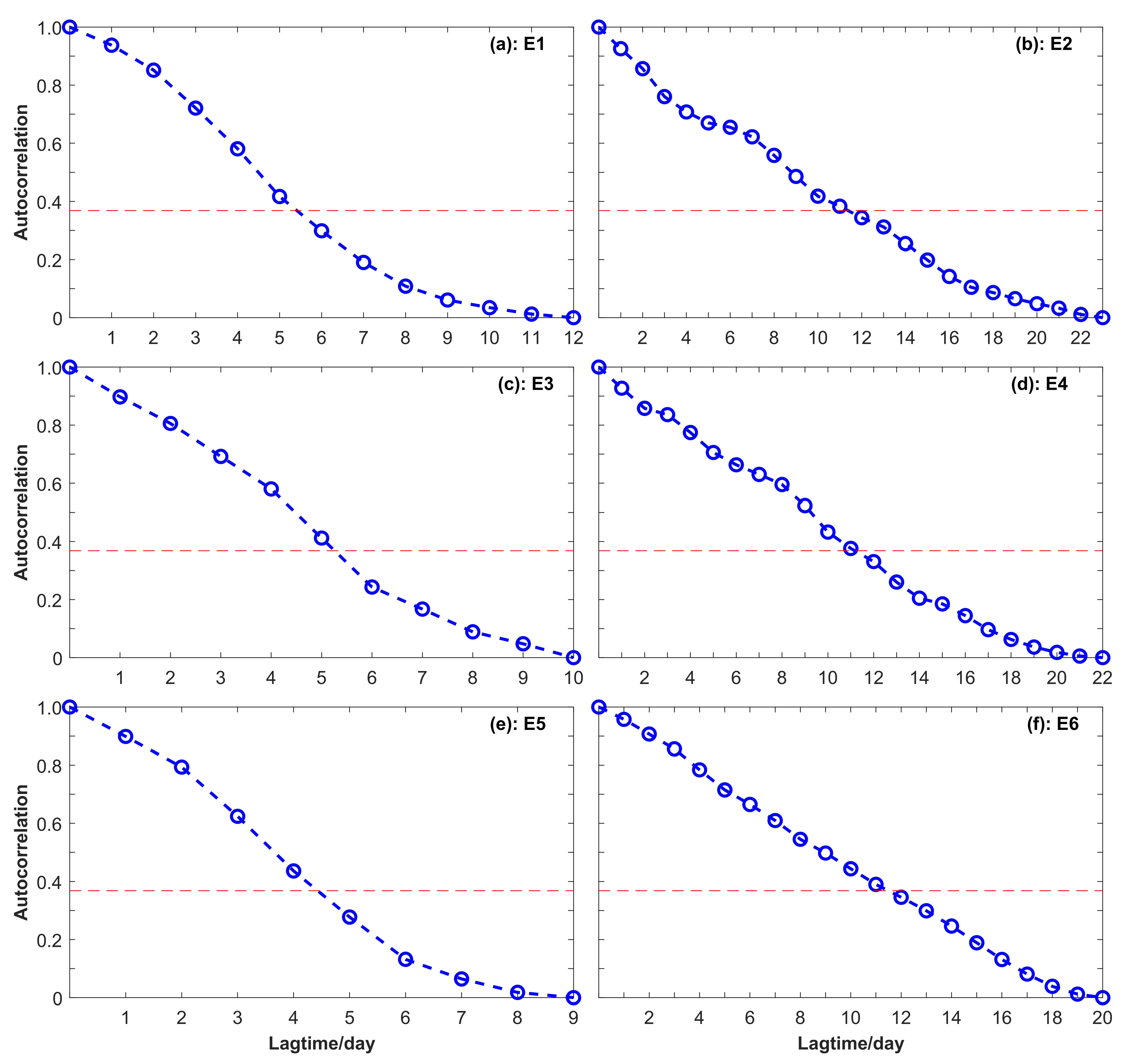
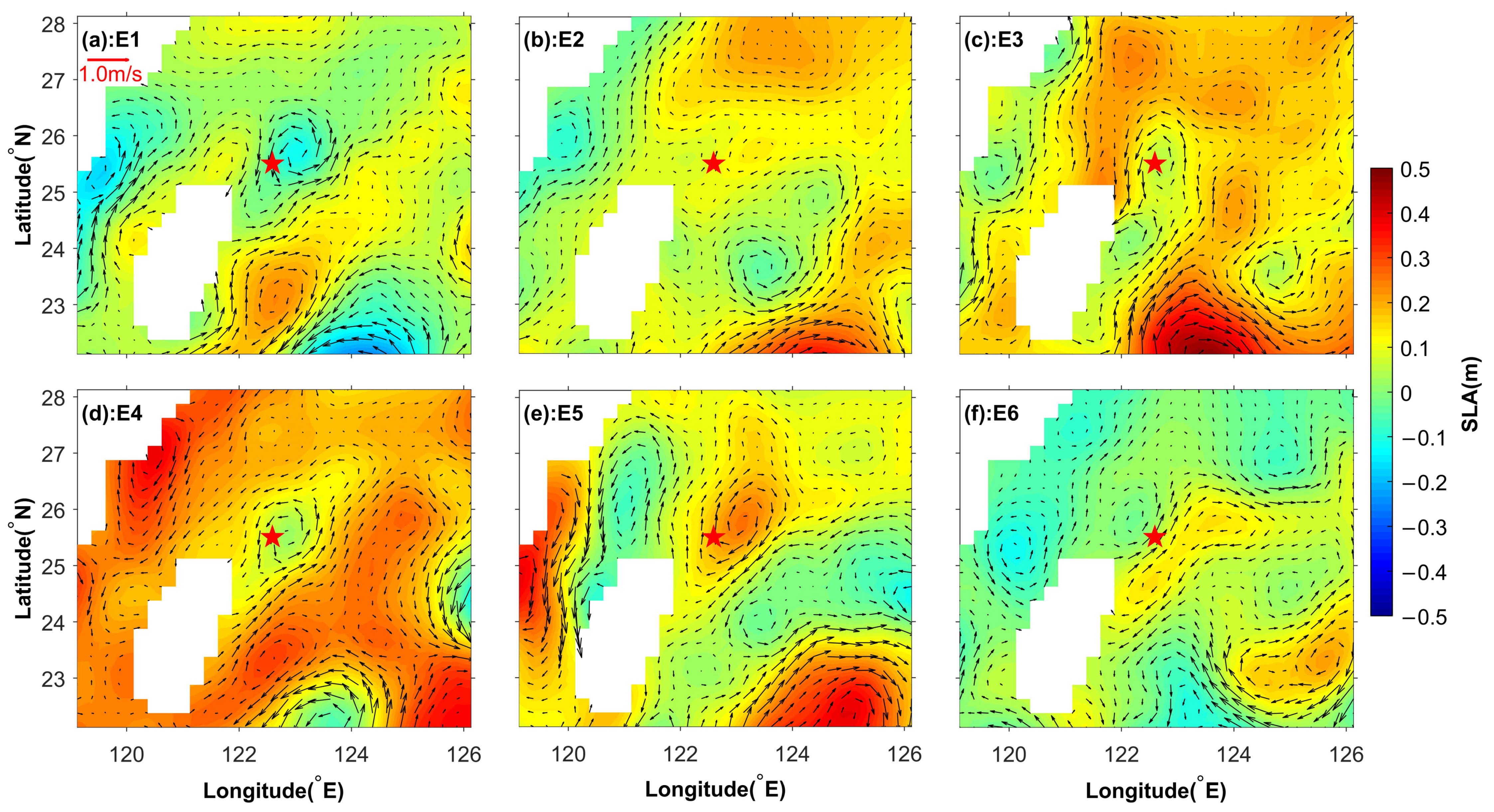
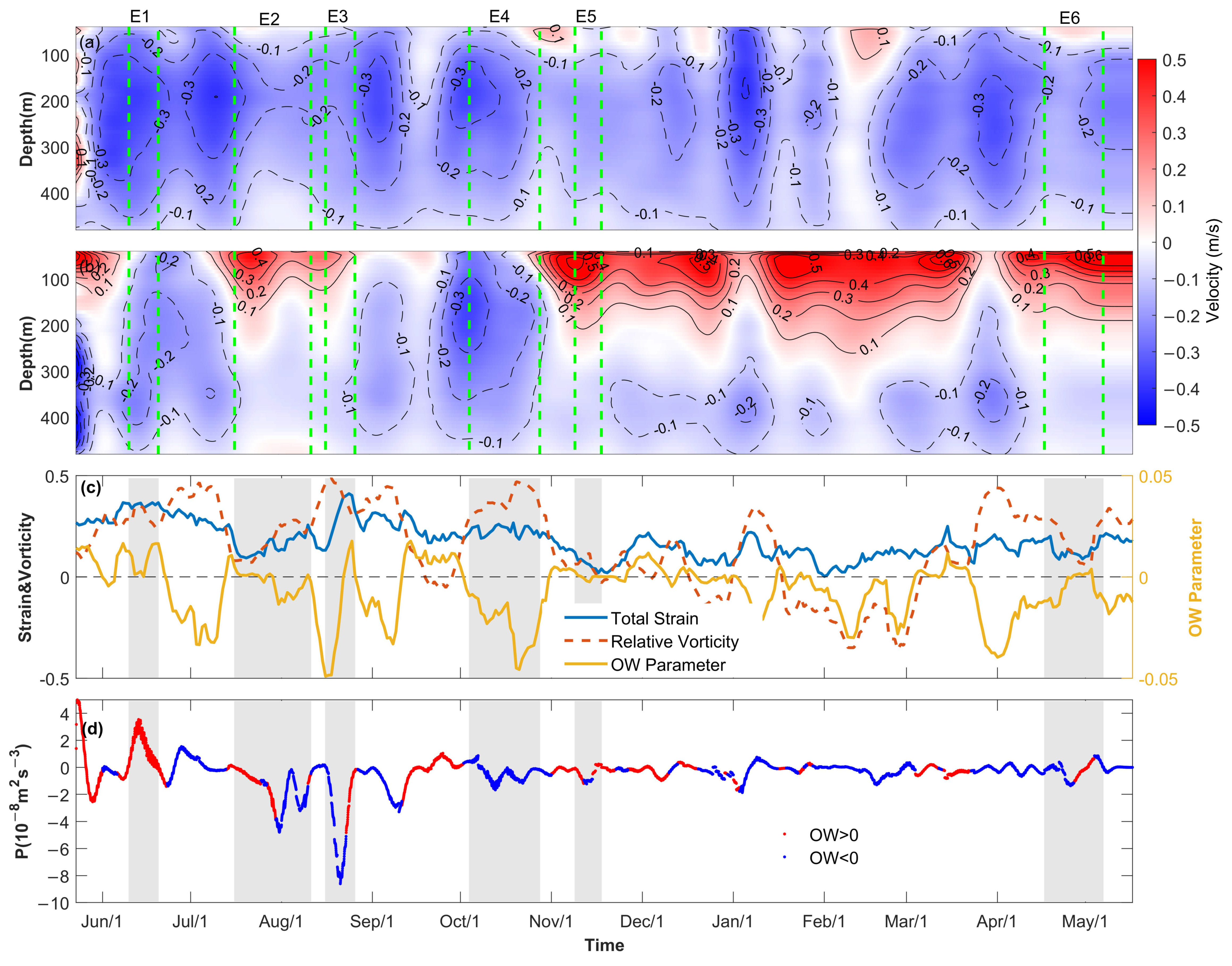
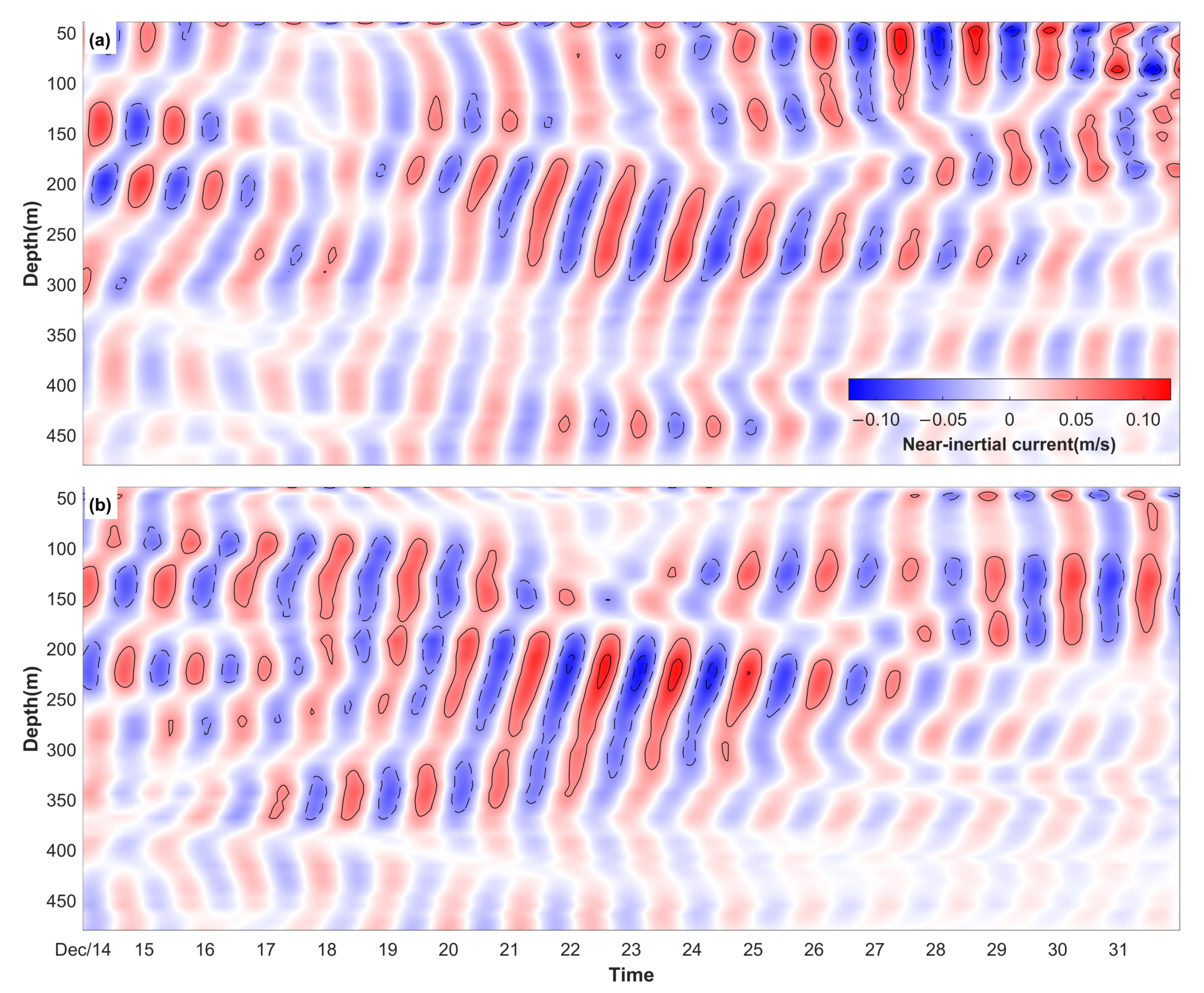
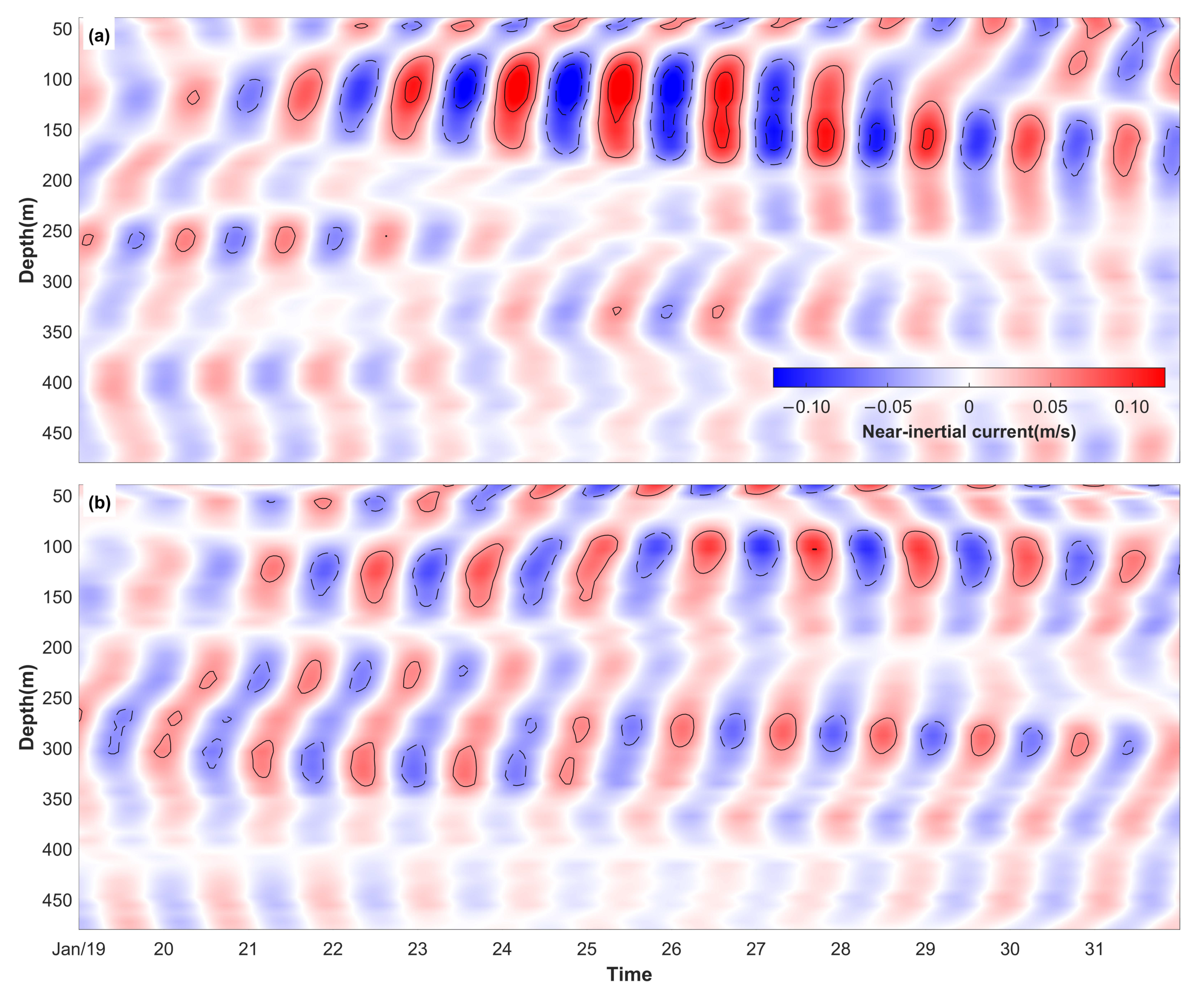
| Episode | Frequency (f) | Phase Speed (m/h) | E-Folding Time (Days) |
|---|---|---|---|
| 1 | 0.960 | NA 1 | 5 |
| 2 | 0.960 | 11.84 | 11 |
| 3 | 0.970 | 6.10 | 5 |
| 4 | 1.035 | 4.85 | 11 |
| 5 | 0.950 | 8.62 | 4 |
| 6 | 0.960 | 4.49 2/5.92 3 | 11 |
Publisher’s Note: MDPI stays neutral with regard to jurisdictional claims in published maps and institutional affiliations. |
© 2021 by the authors. Licensee MDPI, Basel, Switzerland. This article is an open access article distributed under the terms and conditions of the Creative Commons Attribution (CC BY) license (https://creativecommons.org/licenses/by/4.0/).
Share and Cite
Yang, B.; Hu, P.; Hou, Y. Variation and Episodes of Near-Inertial Internal Waves on the Continental Slope of the Southeastern East China Sea. J. Mar. Sci. Eng. 2021, 9, 916. https://doi.org/10.3390/jmse9080916
Yang B, Hu P, Hou Y. Variation and Episodes of Near-Inertial Internal Waves on the Continental Slope of the Southeastern East China Sea. Journal of Marine Science and Engineering. 2021; 9(8):916. https://doi.org/10.3390/jmse9080916
Chicago/Turabian StyleYang, Bing, Po Hu, and Yijun Hou. 2021. "Variation and Episodes of Near-Inertial Internal Waves on the Continental Slope of the Southeastern East China Sea" Journal of Marine Science and Engineering 9, no. 8: 916. https://doi.org/10.3390/jmse9080916
APA StyleYang, B., Hu, P., & Hou, Y. (2021). Variation and Episodes of Near-Inertial Internal Waves on the Continental Slope of the Southeastern East China Sea. Journal of Marine Science and Engineering, 9(8), 916. https://doi.org/10.3390/jmse9080916







